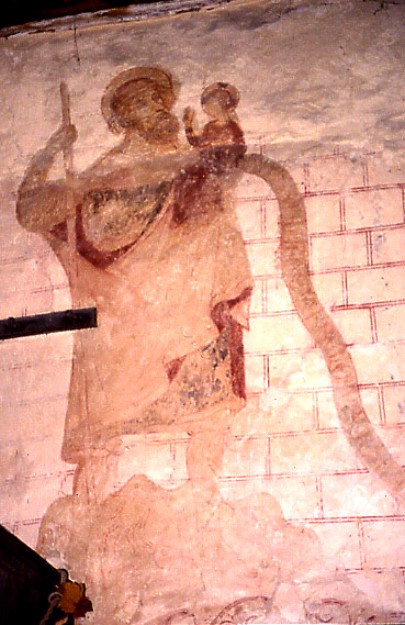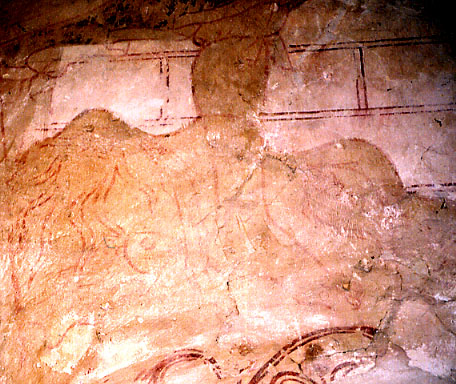Woodeaton, Oxfordshire (†Oxford) C.14
St Christopher

A St Christopher with a very full inscription spelling out the saint’s protective powers. The masonry pattern behind Christopher is a little earlier, and incidental details are confined to the area around the saint’s legs and feet. The inscription, on a very long scroll to the right, is unfortunately almost impossible to read now, but it once declared, in the Norman French still dominant among the upper classes in mid-14th century England KI CEST IMAGE VERRA LE IUR DE MALE MORT NE MURRA. But the Saint’s reassuring message would have needed no translating for ordinary people of the day. Just visible at the lower left is the blocked north door, which may have been in use in medieval times.
Christopher’s head and neck and the upper part of the Christ Child had been damaged, and were repainted in 1932 in what Tristram calls a ‘rough outline’.¹ ET Long claims that this restoration was Tristram’s own², but I am uncertain, and in any case the painting may well have been restored again since then.

Although there are no incidents from Christopher’s eventful life here, the painter has allowed his imagination free reign with the aquatic life around his feet. Swimming in the water (detail, left) are various fish, all rather faint now, and between Christopher’s feet, an octopus. It is not unusual, even in areas far inland, to see marine fish and other saltwater creatures accompanying St Christopher, and of course exotic animals such as octopuses might be copied from from manuscript paintings or bestiaries. Christopher’s short breeches, less elaborate than those at Paston in Norfolk, but knotted below the knee in the same way, also show quite well here.
There is more masonry pattern on other walls, some decorative painting and very faint traces of another subject elsewhere. There is also a very well preserved Rood Beam, inscribed with the words Venite benedicte patris mea ite maledicte in ignem aeternam (‘Come ye blessed of my father, go to the eternal fire, ye accursed’), which might mean that there was once a Doom over the chancel arch.
Website for Church of the Holy Rood, Woodeaton
¹Tristram II, p.268
² ET Long, Medieval Wall Paintings in Oxfordshire Churches, Oxfordshireiensia, vol. XXXVII, 1972, p.106
† in page heading = Diocese